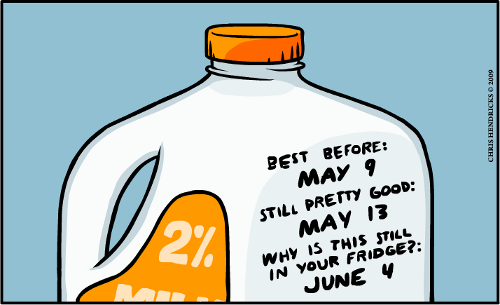How to Calculate Shelf Life of Food

A lot of requirements stand between a great food product and a store shelf. ReciPal has you covered for nutrition label software, recipe cost calculating, and ingredient lists, and we want to make sure you know what you need beyond that.
We'll give you some insights into how to determine shelf life of food products and why it’s important. We even have some practical tips on determining shelf life of food yourself without breaking the bank.
If you prefer to learn over video, we have a version on our YouTube Channel and embedded below:
Why Food Shelf Life Testing Is Important
Aside from infant formula, the regulators do not require expiration dates on food products. In other words, you’re not under a legal obligation to put a date on your food. But that doesn’t necessarily mean it’s optional because many stores you'll be selling to may require you to provide your product’s shelf life.
That requirement comes in large part from a core principle of U.S. food law: foods must be fit for consumption. Just because there isn’t a law requiring you to have an expiration date on a package doesn't mean you can sell food that has gone bad. So if you're selling food, you want to know how long you can keep it on the shelf, both for quality and for safety. Shelf-life information is the easiest way for stores to keep track of the fitness of the foods they stock.
Shelf life of food also matters for production since it affects how much inventory you hold and how much you release at a time to distributors or retailers based on sales velocity. Some things might last more or less forever and others no more than a couple of months. Understanding that is critical for maintaining quality which is in turn critical for your business. Ultimately, knowing your product shelf life helps with establishing trust with your partners and customers.
Factors That Impact Food Shelf Life
How long a food lasts depends on factors like ingredients, manufacturing process, packaging, and storage conditions. Certain ingredients, like salt, vinegar, and sugar can act as preservatives. Your manufacturing process and the relative pH of the food can make a big difference. Dry foods are less susceptible to spoiling because there’s no moisture for molds to grow, and storage temperatures (frozen versus fresh) greatly affect the food product shelf life. So does exposure to light or air, so the type of packaging makes a big difference in the life of the food.
Things to Consider When Doing Food Shelf Life Testing
Because of all of these factors, before you begin any shelf-life study, however informal, you should have a finalized recipe and production process. Changing ingredients, packaging, and processing can alter not only the product but its shelf life as well, so what goes into your food, how you make it, and how you pack it all have to be settled for shelf-life testing to be valid.
The shelf life of a food product is counted from the time the food is fully processed and packaged. There is a difference between when the food starts to spoil and when it starts losing quality. Some of our customers care more about the quality, so even if a product hasn't spoiled they might not be happy selling it to customers after a certain point. That’s a preference. But remember that selling anything that has started to spoil is not allowed.
Lastly, certain products have specific regulations on shelf life regarding "sell-by" dates and "best-by" dates. Do your research and figure out where your product falls before doing any testing.
Methods to Determine Your Product’s Shelf Life
The options for determining the shelf life of food products vary in reliability, complexity, and cost. You can:
- Check competitors' labels.
- Conduct an informal study yourself.
- Use a lab that does formal shelf life studies to test microbial spoilage. Connect with our partner lab.
The most reliable and fastest approach is often to get an analysis done by a lab. Labs have methods for accelerating the process so they can mimic 1 month of shelf life in a fraction of that time. They also have commercial grade equipment to test contaminants and microbial levels, so it's a much more scientific process than you'd conduct otherwise. For those reasons it's also the most expensive option in terms of up front costs. If you're interested in lab analysis, we partner with a great lab to conduct shelf life studies.
But even if you're not ready to spend the money for a formal shelf-life study, you can get useful information through the other two options.
Checking competitors' labels is a good first step. Do they all have similar "best-by" dates? That can give you a sense of the range you’re looking at for your own product and might be a good starting point for setting a date. Of course be aware that this approach can only give you a general range since other producers may use different ingredients, processing techniques, and packaging.
If you decide to get more specific and have some time before you need to add a date to your packaging, then conduct your own informal study. Take your product and store it under your recommended storage conditions. Are you telling your customers on your packaging to refrigerate the item? Then make sure you leave it in the fridge. Are you selling something shelf-stable? Leave it on the shelf. Every few weeks, open a container and take detailed notes. Maybe take photos as well. How does the product look, smell, taste, feel each time you check it? How has it changed from a "fresh" container? Keep checking until you notice changes. You’ll want to set your “best by” date for a period before the changes became noticeable.
You may also want to run basic chemical tests. Does your product require certain pH levels? You can test the pH with basic equipment.
A key point in getting the most out of your informal study is to make sure you have enough samples. To do that, decide what shelf life would make you happy. How many weeks is that? How often do you want to check your samples? Divide the total weeks of testing by how frequently you'll be checking it and have AT LEAST that many samples. You'll likely want a couple of parallel tests going at once so you're testing more than one package each time.
So, for a 15-week study with tests every 2 weeks, you'd need at least 7 or 8 samples. For a 40 day study with tests every 3 days, you'd need at least 13 or 14 samples.
The Difference Between an Expiration Date and Best By Date
We mentioned earlier that there’s a difference between optimal quality and food safety, and that difference can be reflected in the terms used for the dates on a food’s label. Safety dating only applies to infant formula and in some cases, under state law, to eggs.
Here’s how the USDA explains the different shelf life terms you might see:
- A "Best if Used By/Before" date indicates when a product will be of best flavor or quality. It is not a purchase or safety date.
- A "Sell-By" date tells the store how long to display the product for sale for inventory management. It is not a safety date.
- A “Use-By" date is the last date recommended for the use of the product while at peak quality. It is not a safety date except for when used on infant formula as described below.
- A “Freeze-By” date indicates when a product should be frozen to maintain peak quality. It is not a purchase or safety date.
Legal Compliance for Food Shelf Life Testing
Food is a highly regulated industry, and there are many federal rules that govern everything from safe handling to ingredients to food-grade packaging to labeling. But shelf-life testing for food products is not part of that compliance structure for anything except infant formula. Of course that might change as food waste becomes more and more of an issue, but for now shelf life is a business concern and not a regulatory one.






